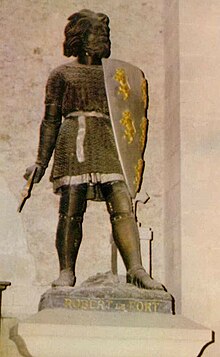Robert the Strong
This article needs additional citations for verification. (January 2018) |
Robert the Strong | |
|---|---|
Robert III of Worms (most probably) | |
| Mother | Waldrada of Worms (most probably) |


Robert the Strong (French: Robert le Fort; c. 830 – 866) was the father of two kings of West Francia: Odo (or Eudes) and Robert I of France. His family is named after him and called the Robertians. In 853, he was named missus dominicus by Charles the Bald, King of West Francia. Robert the Strong was the great-grandfather of Hugh Capet and thus the ancestor of all the Capetians.
Origins and rise to power
The parentage of Robert the Strong is obscure. While very little is known about the beginnings of the Robertian family, speculative proposals have been made. According to one proposal, Robert was a son of
According to the Worms proposal, during the reign of
Revolt
In 858 Robert joined a rebellion against Charles the Bald. With the Bretons under
Robert's Neustrians chased Louis the Stammerer from Le Mans in 858. Later that year, Louis the German reached
In 862 Charles granted Louis the Stammerer, his son, the lay abbacy of
In 862 two Viking fleets converged on Brittany; one had recently been forced out of the
Robert's apparent purpose was to prevent the Vikings from serving Salomon.
Robert warred with Pepin II in his later years. In 863 he again defended Autun from Louis the German; he campaigned in Neustria in 865 and again in 866, shortly before his death, dealing with Bretons and Vikings ravaging the environs of Le Mans.[citation needed]
Death and legacy

On 2 July 866, Robert was killed at the Battle of Brissarthe while defending Francia against a joint Breton-Viking raiding party led by Salomon, King of Brittany and the Viking chieftain Hastein. During the battle the Viking commander was entrapped in a nearby church. Robert removed his armour to start to besiege the church; the Vikings then launched a surprise attack and Robert died in the subsequent melee.[4] He left behind a nine-year-old son, Odo (who would later be King of France), as his heir. His heroic successes against the Vikings led to his characterization as "a second Maccabaeus" in the Annales Fuldenses.[citation needed]
Family
Robert married Adelaide of Tours, daughter of Hugh of Tours.[4] They had:[c]
- Odo of France (c.857–898), King of West Francia[6]
- Robert I of France (c.866–923), King of West Francia.[6]
Notes
- ^ Robert probably expected Salomon to hire them to replace the defeated Mediterranean Vikings, then to attack Neustria from two sides: with the Viking ships ascending the Loire and Breton troops invading by land.
- ^ In 860–1 Charles the Bald had collected a general tax to pay a Danegeld of 5,000 pounds. The king had probably authorised Robert's payment.
- ^ It is not universally acknowledged that Odo and Robert were also Adelaide's sons.[5]
References
- ^ Detlev Schwennicke, Europäische Stammtafeln: Stammtafeln zur Geschichte der Europäischen Staaten, Neue Folge, Band II (Marburg, Germany: J. A. Stargardt, 1984), Tafel 10
- ISBN 978-0-8122-4636-0.
- ^ Einar Joranson (1923), The Danegeld in France (Rock Island: Augustana), 59–61.
- ^ ISBN 978-1-85285-528-4
- ^ Jackman 2008, p. 42.
- ^ a b Riche 1983, table 4.
Sources
- Jackman, Donald C. (2008). Comparative Accuracy. Editions Endlaplage.
- Riche, Pierre (1983). The Carolingians: A Family who Forged Europe. Translated by Allen, Michael Idomir. University of Pennsylvania Press.
- Smith, Julia M. H. Province and Empire: Brittany and the Carolingians. Cambridge University Press: 1992. ISBN 0-521-38285-8
- Hummer, Hans J. Politics and Power in Early Medieval Europe: Alsace and the Frankish Realm 600 – 1000. Cambridge University Press: 2005. ISBN 0-521-85441-5
External links
- Baldwin, Stewart (26 July 2008). "Robert 'le Fort' (Rotbertus Fortis, Robert 'the Strong')". Henry Project.
